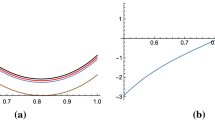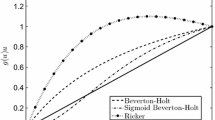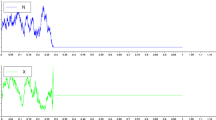Abstract
Diffusion approximations are ascertained from a two-time-scale argument in the case of a group-structured diploid population with scaled viability parameters depending on the individual genotype and the group type at a single multi-allelic locus under recurrent mutation, and applied to the case of random pairwise interactions within groups. The main step consists in proving global and uniform convergence of the distribution of the group types in an infinite population in the absence of selection and mutation, using a coalescent approach. An inclusive fitness formulation with coefficient of relatedness between a focal individual J affecting the reproductive success of an individual I, defined as the expected fraction of genes in I that are identical by descent to one or more genes in J in a neutral infinite population, given that J is allozygous or autozygous, yields the correct selection drift functions. These are analogous to the selection drift functions obtained with pure viability selection in a population with inbreeding. They give the changes of the allele frequencies in an infinite population without mutation that correspond to the replicator equation with fitness matrix expressed as a linear combination of a symmetric matrix for allozygous individuals and a rank-one matrix for autozygous individuals. In the case of no inbreeding, the mean inclusive fitness is a strict Lyapunov function with respect to this deterministic dynamics. Connections are made between dispersal with exact replacement (proportional dispersal), uniform dispersal, and local extinction and recolonization. The timing of dispersal (before or after selection, before or after mating) is shown to have an effect on group competition and the effective population size.
Similar content being viewed by others
References
Aoki K (1982) A condition for group selection to prevail over counteracting individual selection. Evolution 36: 832–842
Boorman S, Levitt PR (1973) Group selection on the boundary of a stable population. Theor Popul Biol 4: 85–128
Boorman S, Levitt PR (1980) The genetics of altruism. Academic Press, New York
Cherry JL (2003a) Selection in a subdivided population with dominance or local frequency dependence. Genetics 163: 1511–1518
Cherry JL (2003b) Selection in a subdivided population with local extinction and recolonization. Genetics 164: 789–795
Cherry JL, Wakeley J (2003) A diffusion approximation for selection and drift in a subdivided population. Genetics 163: 421–428
Christiansen FB (1975) Hard and soft selection in a subdivided population. Am Nat 109: 11–16
Clark AB (1978) Sex ratio and local resource competition in a prosimian primate. Science 201: 163–165
Crow JF, Kimura M (1970) An introduction to population genetics theory. Harper and Row, New York
Deakin MAB (1966) Sufficient conditions for genetic polymorphism. Am Nat 100: 690–692
Eshel I (1972) On the neighbor effect and the evolution of altruistic traits. Theor Popul Biol 3: 258–277
Ethier SN (1976) A class of degenerate diffusion processes occurring in population genetics. Comm Pure Appl Math 29: 483–493
Ethier SN, Nagylaki T (1980) Diffusion approximations of Markov chains with two time scales and applications to population genetics. Adv Appl Prob 12: 14–49
Ewens WJ (1972) The sampling theory of selectively neutral alleles. Theor Popul Biol 3: 87–112
Ewens WJ (1989) An interpretation and proof of the fundamental theorem of natural selection. Theor Popul Biol 36: 167–180
Ewens WJ (2004) Mathematical population genetics, 2nd edn. Springer, New York
Fisher RA (1930) The genetical theory of natural selection. Clarendon Press, Oxford
Gantmacher FR (1959) The theory of matrices, vol 2. Chelsea, New York
Gillois M (1965) Relation d’identité en génétique I.—Postulats et axiomes mendéliens. Ann Inst Henri Poincaré B2: 1–94
Grafen A (1985) A geometric view of relatedness. Oxford Surv Evol Biol 2: 28–89
Griffiths WJ, Lessard S (2005) Ewens’ sampling formula and related formulae: combinatorial proofs, extensions to variable population size and applications to ages of alleles. Theor Popul Biol 68: 167–177
Hamilton WD (1964) The genetical evolution of social behaviour I and II. J Theor Biol 7: 1–52
Hamilton WD (1967) Extraordinary sex ratios. Science 156: 477–488
Hamilton WD (1970) Selfish and spiteful behaviour in an evolutionary model. Nature 228: 1218–1220
Hofbauer J, Sigmund K (1998) Evolutionary games and population dynamics. Cambridge University Press, Cambridge
Hofbauer J, Sigmund K (2003) Evolutionary game dynamics. Bull Am Math Soc 40: 479–519
Karlin S, Taylor HM (1975) A first course in stochastic processes, 2nd edn. Academic Press, New York
Karlin S, Taylor HM (1981) A second course in stochastic processes. Academic Press, New York
Karlin S, Matessi C (1983) Kin selection and altruism. Proc R Soc Lond Ser B 219: 327–353
Kimura M (1964) Diffusion models in population genetics. J Appl Prob 1: 177–232
Kimura M (1984) Evolution of an altruistic trait through group selection as studied by the diffusion equation method. IMA J Math Appl Med Biol 1: 1–15
Kingman JFC (1961) A matrix inequality. Quart J Math 12: 78–80
Kingman JFC (1982) The coalescent. Stoch Proc Appl 13: 235–248
Kurtz TG (1975) Semigroups of conditioned shifts and approximation of Markov processes. Ann Prob 3: 618–642
Lessard S (1992) Relatedness and inclusive fitness with inbreeding. Theor Popul Biol 42: 284–307
Lessard S (1993) Adaptive topography in fertility-viability selection models: an alternative to inclusive fitness in kin selection models. Theor Popul Biol 43: 281–309
Lessard S (1997) Fisher’s fundamental theorem of natural selection revisited. Theor Popul Biol 52: 119–136
Lessard S (2005a) Long-term stability from fixation probabilities in finite populations: New perspectives for ESS theory. Theor Popul Biol 68: 19–27
Lessard S (2005b) Kin selection is implicated in partial sib-mating populations with constant viability differences before mating. Genetics 171: 407–413
Lessard S (2007) An exact sampling formula for the Wright–Fisher model and a conjecture about the finite-island model. Genetics 177: 1249–1254
Lessard S, Rocheleau G (2004) Kin selection and coefficients of relatedness in family-structured populations with inbreeding. Theor Popul Biol 66: 287–306
Levene H (1953) Genetic equilibrium when more than one ecological niche is available. Am Nat 87: 311–313
Levins R (1970) Extinction. In: Gerstenhaber M(eds) Some mathematical questions in biology. Lectures on Mathematics in the Life Sciences, vol 2. American Mathematical Society, Providence, pp 75–107
Lewontin RC (1965) Selection in and of populations. In: Moore JA(eds) Ideas in modern biology. Natural History Press, New York, pp 292–311
Malécot G (1946) La consanguinité dans une population limitée. C R Acad Sci Paris 222: 841–843
Maruyama T (1983) Stochastic theory of population genetics. Bull Math Biol 45: 521–554
Maynard Smith J (1964) Group selection and kin selection. Nature 201: 1145–1147
Maynard Smith J, Price G (1973) The logic of animal conflicts. Nature 246: 15–18
Michod RE, Hamilton WD (1980) Coefficients of relatedness in sociobiology. Nature 288: 694–697
Moran PAP (1958) Random processes in genetics. Proc Camb Phil Soc 54: 60–71
Moran PAP (1959) The theory of some genetical effects of population subdivision. Austr J Biol Sci 12: 109–116
Nagylaki T (1980) The strong-migration limit in geographically structured populations. J Math Biol 9: 101–114
Nagylaki T (1987) Evolution under fertility and viability selection. Genetics 115: 367–375
Nagylaki T (1989) The diffusion model for migration and selection. In: Hastings A(eds) Some mathematical questions in biology: models in population biology. Lectures on Mathematics in the Life Sciences vol, 20. American Mathematical Society, Providence, pp 55–75
Nagylaki T (1996) The diffusion model for migration and selection in a dioecious population. J Math Biol 34: 334–360
Nagylaki T (1997) The diffusion model for migration and selection in a plant population. J Math Biol 35: 409–431
Pitman J (1999) Coalescents with multiple collisions. Ann Probab 27: 1870–1902
Price GR (1970) Selection and covariance. Nature (London) 227: 520–521
Price GR (1972) Extension of covariance selection mathematics. Am Hum Genet Lond 35: 485–490
Rousset F (2003) Effective size in simple metapopulation models. Heredity 91: 107–111
Rousset F (2006) Separation of time scales, fixation probabilities and convergence to evolutionarily stable states under isolation by distance. Theor Popul Biol 69: 165–179
Rousset F, Billiard S (2000) A theoretical basis for measures of kin selection in subdivided populations: finite populations and localized dispersal. J Evol Biol 13: 814–825
Roze D, Rousset F (2003) Selection and drift in subdivided populations: a straightforward method for deriving diffusion approximations and applications involving dominance, selfing and local extinctions. Genetics 165: 2153–2166
Roze D, Rousset F (2004) The robustness of Hamilton’s rule with inbreeding and dominance: Kin selection and fixation probabilities under partial sib-mating. Am Nat 164: 214–231
Sagitov S (1999) The general coalescent with asynchronous mergers of ancestral lines. J Appl Probab 36: 1116–1125
Slatkin M (1977) Gene flow and genetic drift in a species subject to frequent local extinctions. Theor Popul Biol 12: 253–262
Taylor PD (1989) Evolutionary stability in one-parameter models under weak selection. Theor Popul Biol 36: 125–143
Taylor PD, Frank SA (1996) How to make a kin selection model. J Theor Biol 180: 27–37
Taylor PD, Irwin AJ, Day T (2000) Inclusive fitness in finite deme-structured and stepping-stone populations. Selection 1: 153–163
Taylor PD, Jonker L (1978) Evolutionarily stable strategies and game dynamics. Math Biosc 40: 145–156
Uyenoyama MK, Feldman MW (1980) Theories of kin and group selection: a population genetics perspective. Theor Popul Biol 17: 380–414
Uyenoyama MK, Feldman MW (1981) On relatedness and adaptive topography in kin selection. Theor Popul Biol 19: 87–123
Uyenoyama MK, Feldman MW, Mueller LD (1981) Population genetic theory of kin selection: multiple alleles at one locus. Proc Natl Acad Sci USA 78: 5036–5040
Wade MJ (1980) Kin selection: its components. Science 210: 665–667
Wade M, McCauley D (1988) Extinction and recolonization: their effects on the genetic differentiation of local populations. Evolution 42: 995–1005
Wakeley J (2003) Polymorphism and divergence for island-model species. Genetics 163: 411–420
Wakeley J, Aliacar N (2001) Gene genealogies in a metapopulation. Genetics 159: 893–905
Wakeley J, Takahashi T (2004) The many-demes limit for selection and drift in a subdivided population. Theor Popul Biol 66: 83–91
Whitlock MC (2003) Fixation probability and time in subdivided populations. Genetics 164: 767–779
Wright S (1922) Coefficients of inbreeding and relationship. Am Nat 56: 330–338
Wright S (1931) Evolution in Mendelian populations. Genetics 16: 97–159
Wright S (1942) Statistical genetics and evolution. Bull Am Math Soc 48: 223–246
Wright S (1943) Isolation by distance. Genetics 28: 114–138
Wright S (1970) Random drift and the shifting balance theory of evolution. In: Kojima K(eds) Mathematical topics in population genetics. Springer, Berlin, pp 1–31
Author information
Authors and Affiliations
Corresponding author
Additional information
In memory of Sam Karlin.
Rights and permissions
About this article
Cite this article
Lessard, S. Diffusion approximations for one-locus multi-allele kin selection, mutation and random drift in group-structured populations: a unifying approach to selection models in population genetics. J. Math. Biol. 59, 659–696 (2009). https://doi.org/10.1007/s00285-008-0248-1
Received:
Revised:
Published:
Issue Date:
DOI: https://doi.org/10.1007/s00285-008-0248-1
Keywords
- Diffusion approximation
- Kin selection
- Island model
- Covariance formulas
- Relatedness coefficients
- Coalescent process
- Group selection
- Effective population size
- Replicator equation
- Fundamental theorem of natural selection




